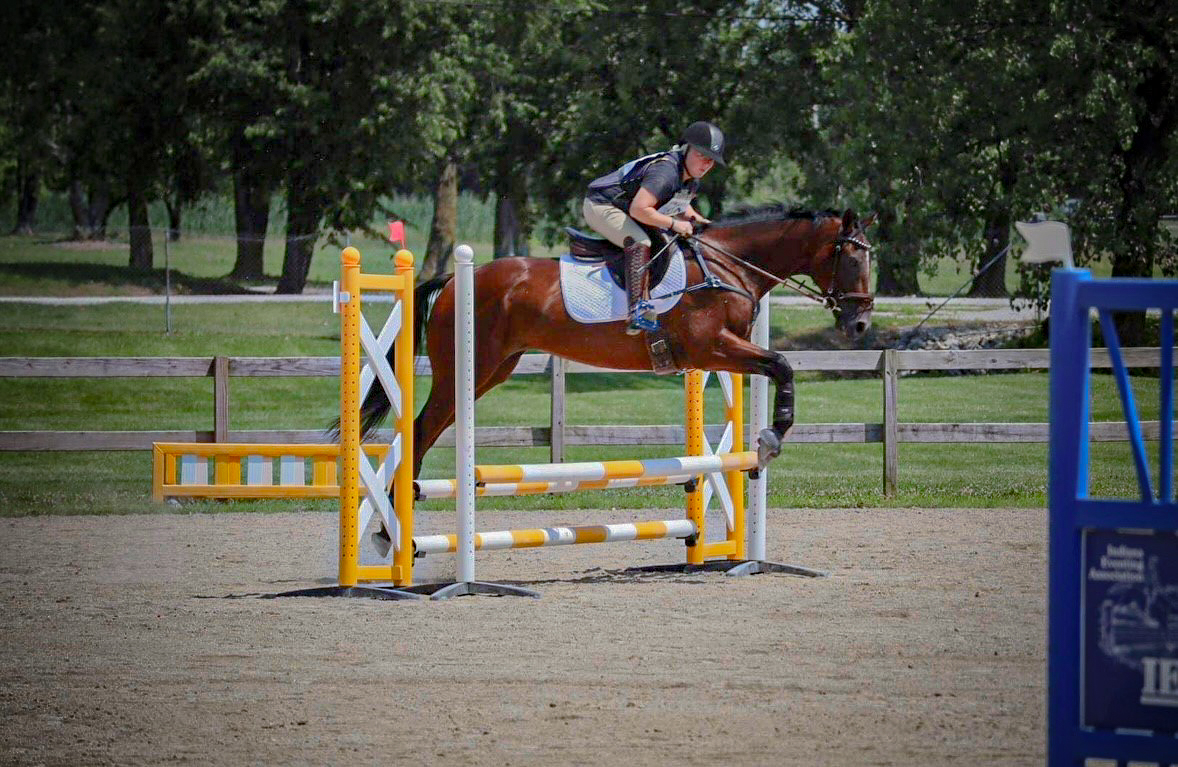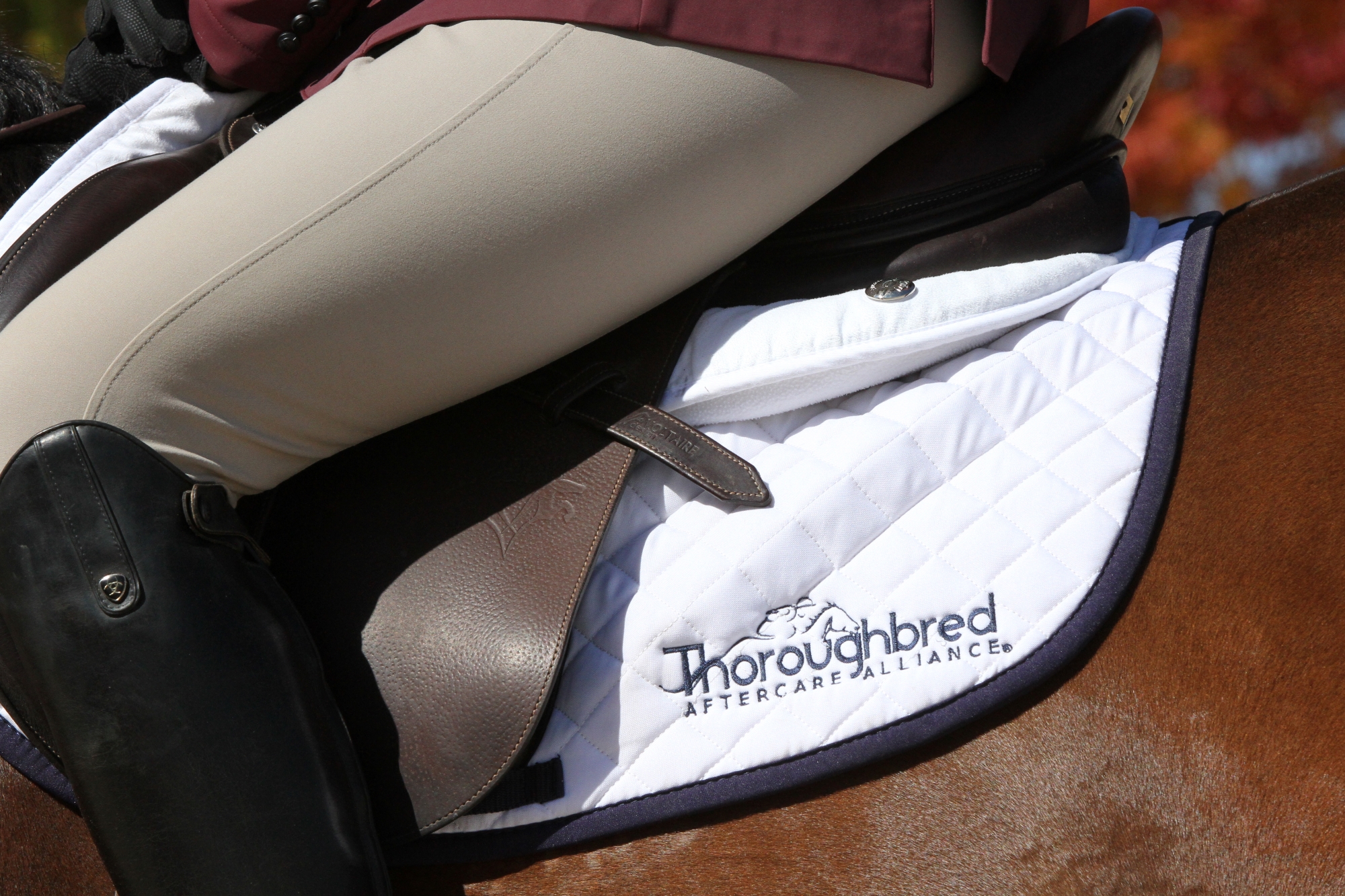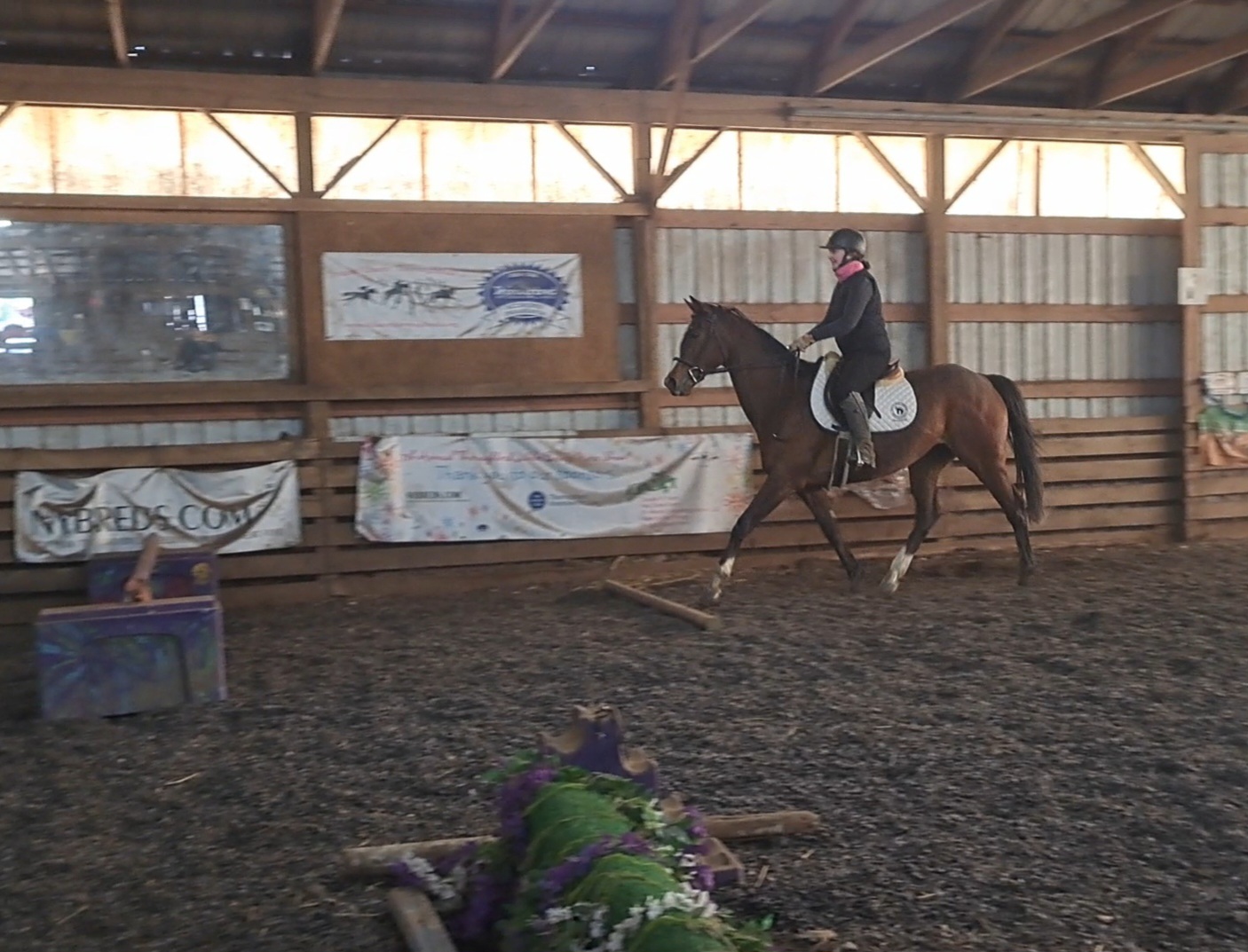More results...
How to Teach Your Retired Racehorse to Jump
How to Teach Your Retired Racehorse to Jump
By: Alexis Arbaugh

Lori Miller, Friends of Ferdinand
Many people who adopt a Thoroughbred after it is retired from racing hope to train their horse for a second career, often in disciplines that involve jumping. Training a Thoroughbred to jump can be a brand-new experience for these retired athletes, as racehorses—unless experienced in steeplechase—don’t engage in jumping or even handling poles. Their primary focus is running on the flat and being trained for speed. Therefore, it can be challenging to teach an off-the-track Thoroughbred how to carefully and skillfully navigate a course of jumps.
Lori Miller is the head trainer at Friends of Ferdinand, an organization accredited by Thoroughbred Aftercare Alliance. Located in Indianapolis, Indiana, Friends of Ferdinand specializes in retraining, rehabilitation, adoption, and providing sanctuary homes for Thoroughbreds retired from racing. Lori has extensive experience with racetracks and retired racehorses and takes pleasure in the retraining process, knowing that racehorses can have happy and healthy lives in new careers. Lori’s wealth of experience and knowledge makes her the perfect person to help fellow adopters navigate their new horse’s retraining process.
It is difficult to determine if a horse will be a good jumper just by looking at them, as there are many factors to consider and different contexts for evaluation. “If you are at the track, it’s tough. A horse that races in blinkers or wears a shadow roll might be one that has a lot to think about,” Lori wrote. Horses that need to wear blinkers to focus generally have excess energy and are spooky. Lori generally tries to avoid spooky horses because it creates more problems when teaching them to jump. “I prefer the horses that will walk with confidence through whatever,” Lori wrote.
Lori also considers conformation when assessing whether a horse would be good at jumping. She likes horses that seem to float when they travel, rather than stomp. She avoids horses with crooked legs, tiny feet, or a downhill build. Instead, she looks for horses that are balanced with an uphill build and correct angles. She prefers straight legs that allow the horse to stand under themselves and a neck that ties in high to their shoulders. Although there are outliers—horses with unconventional conformation that make wonderful jumpers—they are few and far between.
A horse with a good attitude is always easier to work with than one that is grumpy or has a poor attitude. When asked about the kind of attitude or temperament she looks for, Lori replied that she seeks “the horse that wants to work with you, the horse that looks to the person rather than away”. A horse that wants to learn and seeks guidance from people is always going to excel. However, it is easier to evaluate a horse’s willingness after they have had a chance to settle down on a farm following their racing career. It usually takes some time after leaving the track for a horse to come out of its shell and show its true personality. “How they are at the track is frequently very different than they are away from home,” Lori wrote. Any horse that is friendly and easy to work with and around is a good start.
"I want the horse to learn to go over what is put in front of it. Systematically by never asking it to do something we haven’t built up to. Teaching the horse to stay in a rhythm and not run, that there is no reason to get tight and anxious. I want my horses to learn it’s all positive”.

So, now that you have your horse, how do you start jumping? Lori begins with basic flat work to ensure the horse is supple and responsive to the bit. She encourages the horse to move forward off the leg and be quick and accurate with transitions, ensuring the horse is always listening. After establishing a strong flat foundation, she introduces poles on the ground, having the horse casually walk, trot, and canter over them until they are no longer an issue. She wants the horse to get used to riding around standards, poles, and jumps in the arena, encouraging them to watch and continue working.
When Lori feels the horse is ready to jump, she starts with a small jump that the horse can easily walk over. If the horse stops in front of the jump, she breaks it down to make it more inviting. “Slow work to build a confident horse,” Lori wrote. By this point, the horse is accustomed to going over poles and small boxes, so a small cross rail shouldn’t be a big deal. Their first actual jump might be a cross rail or a small log in the field, and the horse shouldn’t be fazed by it. Desensitizing your horse to various obstacles helps prevent stress or nervousness about jumping.
When asked what Lori would like the horse to take away from their first jumping experience, she replied, “I want the horse to learn to go over what is put in front of it. Systematically by never asking it to do something we haven’t built up to. Teaching the horse to stay in a rhythm and not run, that there is no reason to get tight and anxious. I want my horses to learn it’s all positive”.
Lori often trots over fences in the beginning stages of teaching a horse to jump. This allows the horse to learn to make a shape and stay straight while building confidence at a slower and more balanced pace. She advises against over-jumping young horses or those learning to jump, limiting them to jumping no more than twice a week to avoid fatigue and maintain their enthusiasm for the task. “Confidence, a good experience, no stress,” is the goal of the first jump ride, Lori emphasizes.
Colette Duddy, Second Chance Thoroughbreds
Colette Duddy has been the executive director of Second Chance Thoroughbreds in Spencer, New York, since 2011. That fall, she adopted six Thoroughbreds from Finger Lakes Racetrack to be retrained and rehomed, marking the beginning of Second Chance Thoroughbreds.
Conformation is of utmost importance to Colette when deciding whether a horse would be a good jumper. Usually, horses with a good slope to their shoulder and a neck that ties high to the body have the right build to excel at jumping. “Looking at movement, a nice walk and natural canter indicates the horse should be a good jumper,” Colette wrote. Attitude also plays a major role in determining a horse’s potential as a jumper. A horse with a “quiet, willing attitude” but enough energy is best suited for the hunter ring, while a higher-strung horse fits in the jumper ring. However, a lazy or unathletic horse probably won’t excel in jumping. With plenty of good flat work to improve rideability, most horses can be trained to jump in all rings.

Before teaching a horse to jump, Colette ensures they are reliable at the walk, trot, and canter. They need to be steady, straight, and responsive to the rider. Once those qualifications are met, “they are ready to start jumping”. Sometimes, the Pessoa system—a training tool that works the horse’s whole body through ropes attached to a pulley system—helps improve balance and straightness. “Flat work consists of lots of circles at the walk and trot,” Colette said. Circles and ground poles help the horse remain calm and relaxed. She works on many transitions between all gaits, including the halt, ensuring the horse is “in front” of the leg and quickly responding to the rider. “It does not have to be perfect,” Colette wrote, acknowledging that training is always a work in progress.
Second Chance Thoroughbreds and Colette often work with ground poles, starting with one trot pole and gradually adding more as the horse learns where to place its feet. “We start with poles. First just one pole, then add another until there are 3 or 4 poles, about 4 feet apart,” Colette wrote. “When they are trotting over those calmly, we make a cross rail with just one pole in front and build from there including a landing pole about 9 feet away”.
Once a horse is willing to move off the leg and listen to the rider, they are ready to start jumping. Colette and her team believe that the horse should not be distracted by the jump or look at it when they are going over it, which is why Colette allows each horse to sniff and examine the jump before going over it, especially if it is solid and new. Like many other trainers, Colette starts with trotting jumps to keep the horse straight. Once the horse is calmly trotting over the jump, they can progress to cantering, starting with ground poles and then moving to a single cross rail. “As long as the horse is under control,” they can jump the same jump five or six times in the first session. Colette believes that a horse can jump 2 to 3 times a week as long as nothing is “over-drilled.” Ground lines are used before the jump to signal to the horse where to take off.
If a desensitized horse still refuses or fears the jump, Colette lowers it to a single ground pole and walks him over a few times, then trot and build from there. However, if a horse remains scared of jumping, it might not be suited for this activity. Most horses enjoy jumping and find it fun, which is why over-drilling should be avoided to prevent them from losing interest and becoming sour.
The goal of the first jump is for it to be a positive experience. “It needs to be a positive experience, so quitting when the horse has had a couple of successful jumps is enough for the first time,” Colette shared. The horse should enjoy the process, learn a lot, and look forward to doing it again.
About the series
Thoroughbred Aftercare Alliance’s blog series, “Retraining Tips,” aims to support adopters of Thoroughbreds retired from racing with the retraining process. Whether an individual has already adopted or is considering adoption, this series hopes to provide valuable guidance. Thoroughbred Aftercare Alliance has accredited 86 organizations, 63 of which specialize in retraining. Thoroughbred Aftercare Alliance has worked with some of these organizations’ in-house trainers and has compiled a list of the most common tips, advice, and challenges they see, along with instructions on how to work through and overcome them. Throughout the retraining series, Thoroughbred Aftercare Alliance hopes to be a trusted source of retraining information that adopters can use in their retraining process.






